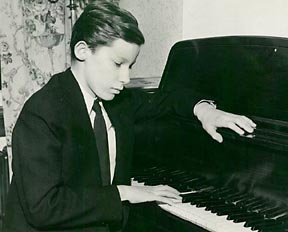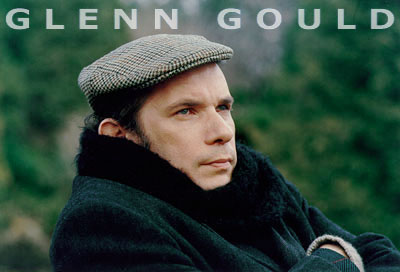Glenn Gould, Master of Counterpoint by Stéphane Villemin
/ February 1, 2000
Version française...
The large amount of discs, films and writings left
by Glenn Gould constitute a gold mine for musicologists as well as
psychiatrists. In the world of music, he was the great iconoclast who excelled
in satire, irony and parody. Who else could have asserted that Mozart had died
too late or that the piano repertory was really quite poor? It was impossible to
define Gould and he remained unrivaled. The only threat he might have felt at
the top of the CN tower came from New York: Horowitz was very famous at that
time, and his staying away from the stage for many years might have influenced
Gould. However, Gould had programmed his entire life since childhood: to have a
career as a concert pianist until the age of 32 and die at 50. He could not
resist ruffling Horowitz’s come-back in his little play called The
Hysterical Return, whose "characters are purely imaginary"(The
Historical Return was the tittle of the disc
celebrating Horowitz’s come-back). Gould was not the only eccentric in piano
history. Vladimir de Pachmann might have stolen the title from Gould. But the
latter’s musical contribution and the imortance of his philosophical approach
made all the difference.
Esthetics and influence

Even before the wave of the baroque had asserted itself, Gould had become its
supporter, though he did not play on period instruments. He proved that with his
modern Steinway CD 318 he could recreate the spirit of the harpsichord–if not
its tone. Bringing new light to technique and phrasing in Bach’s music, he
gave it a second life.
His influence on the young pianists of that period was more important than
one might have realized. At the Conservatory, instead of listening to our
teachers, we all wanted to play Chopin like Pollini, Rachmaninov like Horowitz
and, of course, Bach like Gould. What a mistake that was! His tempos, either
very fast or extremely slow, were just impossible to follow. His feeling for the
non legato phrase was so precise that only he could master all its
different aspects, from portato to staccato quasi pizzicato. He
used the pedal rarely–but wisely.
Clearly, Gould was a man of counterpoint rather than harmony. His love for
horizontality came from his playing the organ as a child. He was never attracted
to verticality. His landmarks were the flatness of Lake Simcoe covered with ice
and Hiroshi Teshigano’s movie "The Sand Woman." In music, it was
Gibbons, Bach, Handel, Haydn, the modern Vienna school and Hindemith. He did,
however, sometimes make an exception for Chopin, Liszt and Rachmaninov. And when
he approached a classical composer, it was mainly through a baroque prism. Only
a few of the Romantics held his attention, and those were mostly from the end of
the century. Wagner, Richard Strauss and Mahler attracted him as the precursors
of the Vienna school, because of their decadent streak. Yet he studied pieces by
Mendelssohn and Brahms, and his recordings of the latter’s Intermezzi dominated
the world of discography.
Gould, the free thinker

From his Toronto headquarters, Gould held a very independent view when it
came to European music. He felt free to create his own "non-Germanic"
interpretations of Wagner and to get rid of the Romantic traits that had been
attached to Bach.
Nevertheless, Gould was no musicologist. His research consisted of reading
the score and working on it, conducting it while walking along Lake Ontario or
singing it in his car. He practiced on his piano no longer than needed to
restore exactly what he had found mentally in the music. "We do not play
the piano with our fingers but with our mind." His way of performing was
completely subjective and personal, but paradoxically he seemed to be able to
appropriate the composer’s soul. His interpretations are unique–they cannot
be classified. However, the public, whose perceptions are also subjective, was
not always convinced by the results. Some people criticized his "Gouldberg
variations"! Colored by puritanism, his cerebral interpretations seemed to
lack feeling; they tended to communicate alarm rather than serenity in his
listeners. His playing made them feel as if they were in an icy desert.
One thing is certain: watching him play, in that odd posture contrary to what
is taught at all the conservatories on the planet, could only be distracting.
Seated on his legendary wooden folding chair (now popularly displayed at the
museum in Ottowa), he held his shoulders barely higher than the keyboard. His
elbows were at times stretched out to a horizontal position. In addition, as
soon as one hand was free, he used it to keep time. He also had the bad habit of
turning all piano pieces into Lieder for whispering voice, for he couldn’t
refrain from humming along as he played, which made life difficult for the sound
engineers at CBC.
Many people still ask themselves whether Gould is an eccentric or a genius,
but the question need no longer be asked: he was an eccentric genius. His talent
was as disturbing as his immoderate taste for provocation.
Gould’s case is unique in the history of the piano and music. Having as
many supporters as detractors, he is still on people’s minds twenty years
after his death. He has been given two posthumous Grammy awards for his
interpretations; Glenn Gould symposiums and festivals are being organized all
over the world; and a space probe is on its way to Mars with his recording of
Bach to reveal the quintessence of Earth’s musical art to the little green
people.
Translated by Annie Prothin from "Les grands pianistes" by
Stéphane Villemin (DPLU).
The Glenn Gould Foundation
The foundation publishes a magazine for its members and organizes seminars
such as the 1999 Glenn Gould Gathering. The event included listening to music,
attending lectures, and screenings of films such as the 1974 three-part series
by Bruno Montsaingeon. Those attending the conference also saw the play Glenn,
by Tom Patterson. The 1999 conference closed with the awarding of the Glenn
Gould Prize to cellist Yo- Yo Ma.
For information, write: Glenn Gould Foundation, PO Box 190, 260 Adelaide St,
East, Toronto, Ontario, M5A 1N1
Dancers too!
The four-act ballet Inspired by Gould was created in Toronto in the fall of
1999, with the participation of the Toronto-based National Ballet of Canada.
Each of the four acts included a reading of the theme by a noted present-day
choreographer. Margie Gillis, Dominique Dumais, William Forsythe, and James
Kudelka each presented a facet of the pianist’s life and character,
demonstrating that in some ways dance is better than words when it comes to
explaining the enigma of Glenn Gould.
Version française... |
|


